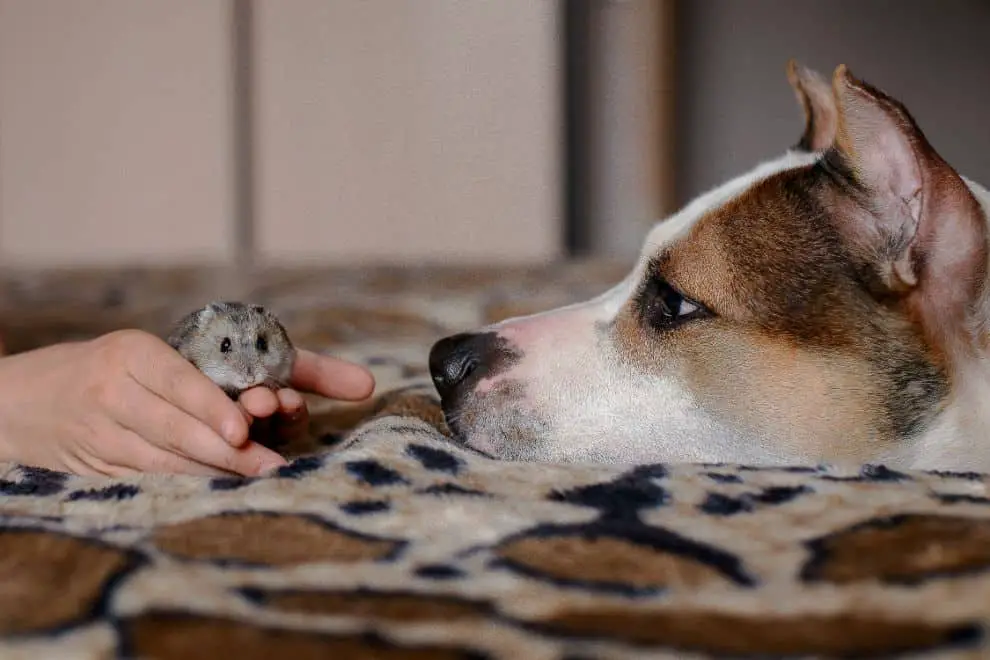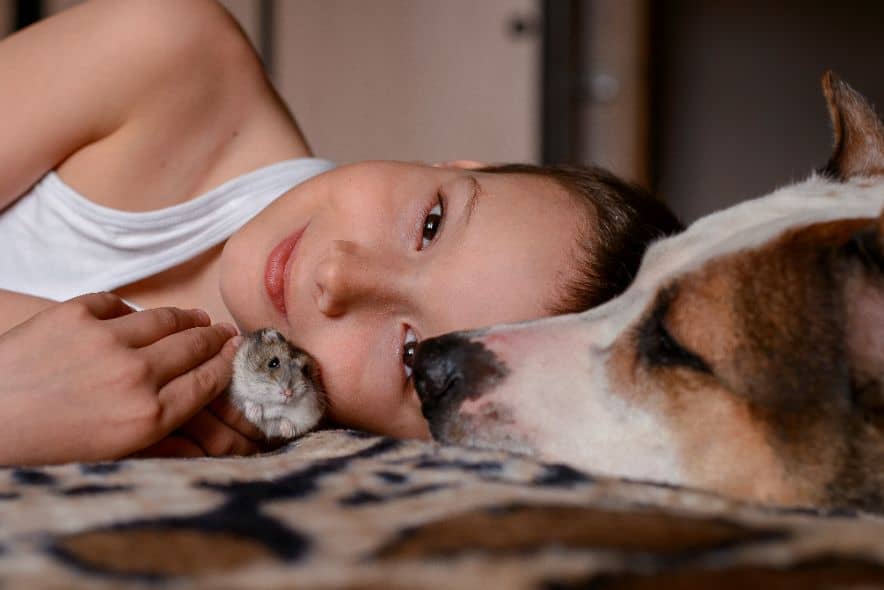Are you a pet lover who wants to keep a hamster and a dog in the same household? While this may seem like a challenging task, it is possible to keep these two pets together with proper preparation, care, and supervision.
In this comprehensive guide, we will discuss the benefits and challenges of keeping a hamster and a dog together, how to choose the right dog breed, steps for introducing your pets, creating a safe environment, behavioral considerations, training your dog, and maintaining a balanced lifestyle for both pets.

Why Keep a Hamster and a Dog Together?
Hamsters and dogs are both adorable pets that can provide companionship and entertainment to their owners. Keeping them together can be a fun and rewarding experience for both humans and animals.
It can also help to teach children about responsibility and empathy towards animals. However, it is important to keep in mind that hamsters are small and fragile animals that require careful handling and protection from potential predators like dogs.
The Challenges and Benefits
Keeping a hamster and a dog in the same household can come with both challenges and benefits. Some of the challenges include the potential for aggression or predatory behavior from the dog towards the hamster, the risk of injury or death to the hamster, and the need for separate living spaces and careful supervision.
However, the benefits of keeping these two pets together include the potential for socialization and entertainment for both pets, as well as the joy of seeing them coexist peacefully.
What to Expect from this Guide
This guide will provide a step-by-step process for introducing your hamster and dog, creating a safe environment, addressing behavioral concerns, and maintaining a balanced lifestyle for both pets. We will also provide tips on choosing the right dog breed, training your dog, and addressing frequently asked questions.
Choosing the Right Dog Breed
When choosing a dog breed to keep with a hamster, it is important to consider the dog’s temperament, energy levels, and prey drive.
Some dogs may have a higher prey drive that makes them more likely to see the hamster as prey. It is important to choose a dog breed that is naturally good with small animals or has a low prey drive. Some dog breeds that are good with small animals include:
- Poodle
- Bichon Frise
- Cavalier King Charles Spaniel
- Maltipoo
- Shih Tzu
On the other hand, some dog breeds that may have a higher prey drive and need to be approached with caution include:
- Greyhound
- Jack Russell Terrier
- Beagle
- Husky
- Border Collie
In addition to considering the dog’s breed, it is important to consider their size and energy levels. A large, energetic dog may accidentally harm the hamster while playing, so it is important to choose a dog that is gentle and calm.
Introducing Your Hamster and Dog

The key to successfully introducing your hamster and dog is to do it gradually and with careful supervision. Here are some steps to follow:
The Initial Meeting
The first step is to allow your dog to sniff the hamster’s cage while the hamster is inside. This will help your dog become familiar with the hamster’s scent without any direct contact.
Supervised Interactions
Once your dog is comfortable with the hamster’s scent, you can start allowing supervised interactions between the two pets.
It is important to keep your dog on a leash and hold your hamster while they are interacting. This will prevent your dog from accidentally harming the hamster.
Gradual Introduction Techniques
Gradual introduction techniques involve slowly increasing the amount of time your dog and hamster spend together while constantly monitoring their interactions.
You can start by allowing them to be in the same room for a few minutes at a time and gradually increasing the duration of their interactions.
Note: You should never leave your dog alone with your hamster!
Creating a Safe Environment
Creating a safe environment for your hamster is crucial when keeping them with a dog. Here are some tips:
Separate Living Spaces for Both Pets
It is important to provide separate living spaces for both your hamster and your dog. You can use a cage or a playpen for your hamster and make sure it is secure and out of reach from your dog.
Choosing the Right Cage for Your Hamster
When choosing a cage for your hamster, make sure it is the appropriate size and has a secure lid. Hamsters are known for being escape artists, and a dog may try to get into the cage if it is not secure.
Securing Your Hamster’s Cage
Make sure your hamster’s cage is in a secure location where your dog cannot reach it. You can also use a baby gate or a pet gate to keep your dog away from the hamster’s living area.
Storing Food and Treats Out of Reach from Your Dog
Make sure to store your hamster’s food and treats in a secure location that is out of reach from your dog. Dogs can be very food motivated, and may try to get into the hamster’s food if it is accessible.
Behavioral Considerations
When keeping a hamster and a dog together, it is important to be aware of any signs that your dog may be predatory towards your hamster. Here are some things to look out for:
Signs Your Dog May Be Predatory Towards Your Hamster
Some signs that your dog may be predatory towards your hamster include:
- Stalking or staring at your hamster
- Barking or lunging at the hamster’s cage
- Trying to dig or scratch at the cage
- Pawing at the cage
- Growling or snarling at the hamster
How to Prevent and Address Any Aggressive Behavior
If you notice any signs of predatory behavior from your dog, it is important to address it immediately. This can involve redirecting your dog’s attention, using positive reinforcement to encourage good behavior around the hamster, or seeking the help of a professional dog trainer.
Teaching Your Dog to Be Gentle Around Your Hamster
It is important to teach your dog to be gentle around your hamster. This can involve using positive reinforcement techniques to encourage gentle behavior, such as giving your dog a treat for sniffing the hamster without any aggression.
Training Your Dog
Training your dog is crucial when keeping them with a hamster. Here are some tips:
The Importance of Obedience Training
Obedience training is important for all dogs, but especially for those living with small animals like hamsters. It can help to ensure that your dog will listen to your commands and stay calm around the hamster.
Teaching Your Dog Basic Commands to Ensure Safety
Some basic commands that can help to ensure safety around your hamster include:
- Sit
- Stay
- Leave it
Positive Reinforcement Techniques to Encourage Good Behavior
Positive reinforcement techniques, such as giving your dog a treat for good behavior around the hamster, can help to encourage gentle and calm behavior.
Maintaining a Balanced Lifestyle
Maintaining a balanced lifestyle for both your hamster and your dog is important when keeping them together. Here are some tips:
Ensuring Both Pets Get Enough Exercise
It is important to ensure that both your hamster and your dog get enough exercise. This can involve providing your dog with daily walks and your hamster with a wheel or playtime outside of their cage.
Making Time for Individual Attention with Both Pets
Make sure to spend individual time with both your hamster and your dog to ensure they are getting the attention they need.
Scheduling Regular Veterinary Check-Ups
Regular veterinary check-ups are important for both your hamster and your dog to ensure they are healthy and happy.
Conclusion
Keeping a hamster and a dog in the same household can be a fun and rewarding experience with proper preparation and care. By following the steps outlined in this guide, you can ensure the safety and happiness of both your pets.
Remember to choose the right dog breed, introduce your pets gradually, create a safe environment, address any behavioral concerns, train your dog, and maintain a balanced lifestyle for both pets. If you have any questions or concerns, don’t hesitate to seek the help of a professional veterinarian or dog trainer.
- How Long Do American Eskimo Dogs Live? Important Factors and Care Tips - September 29, 2023
- Do American Bulldogs Need Grooming? Essential Tips and Care Guidelines - September 29, 2023
- Do Bengal Cats Enjoy Playing? Essential Tips for Keeping Them Active - September 29, 2023